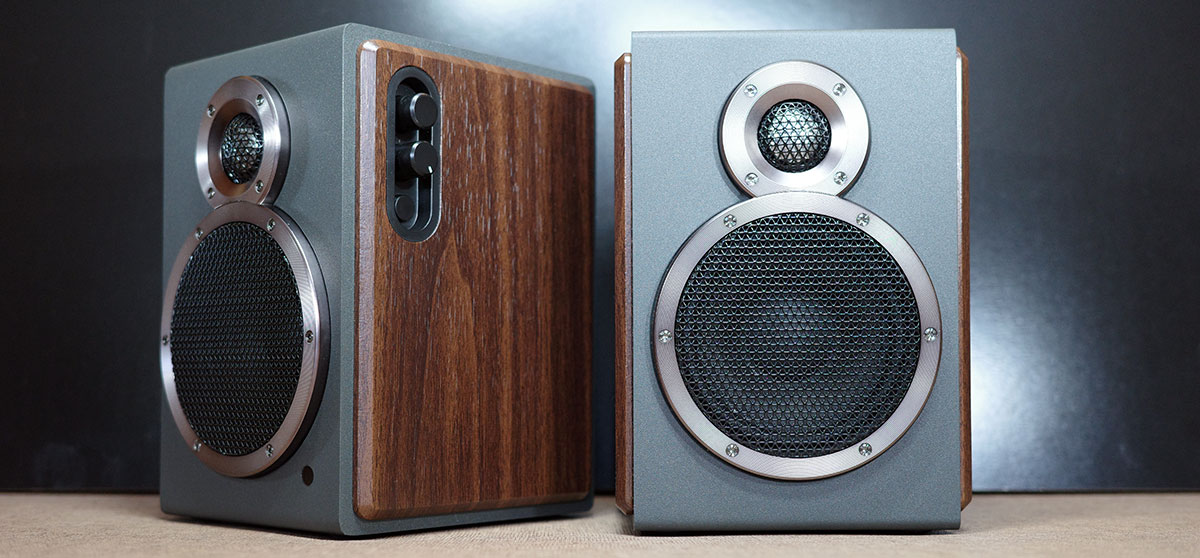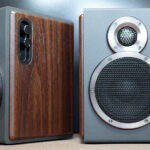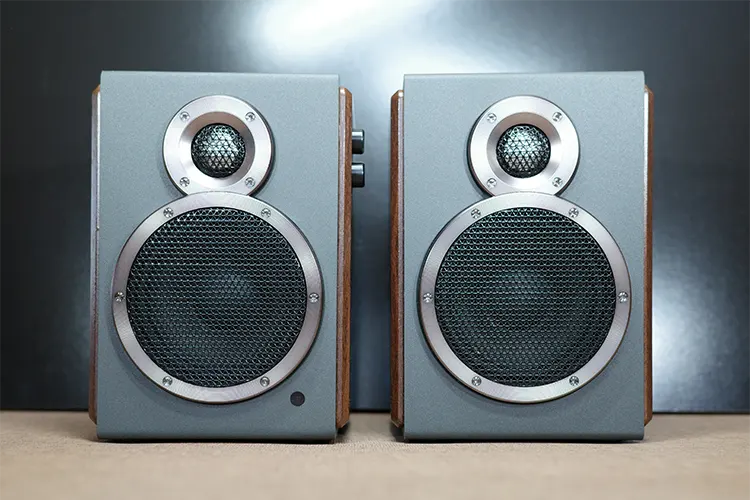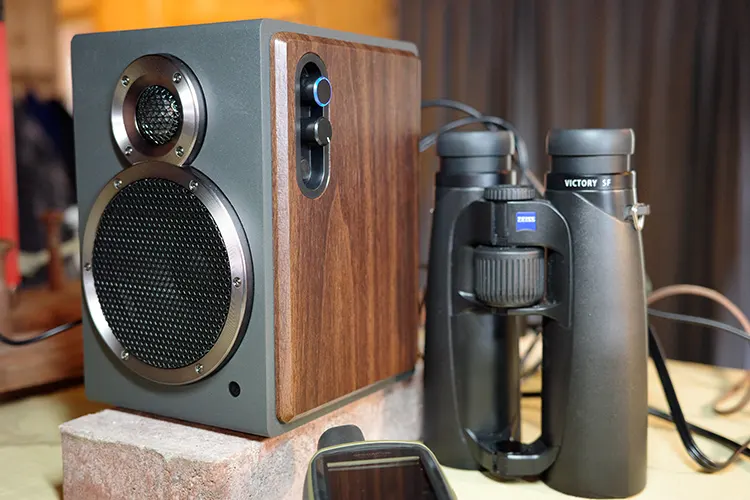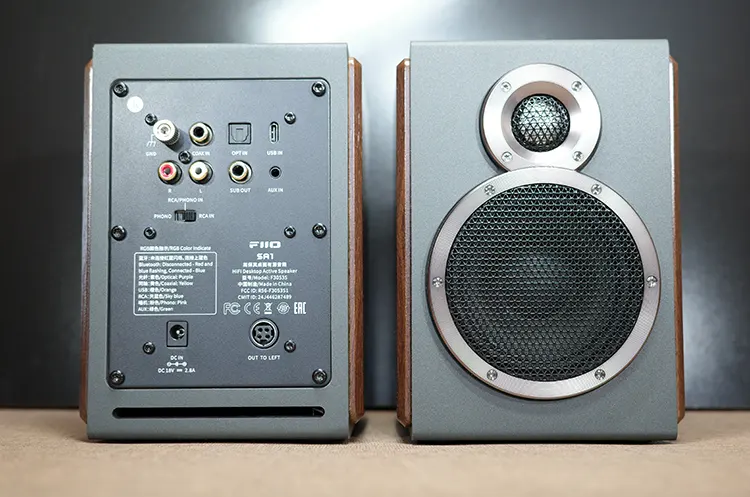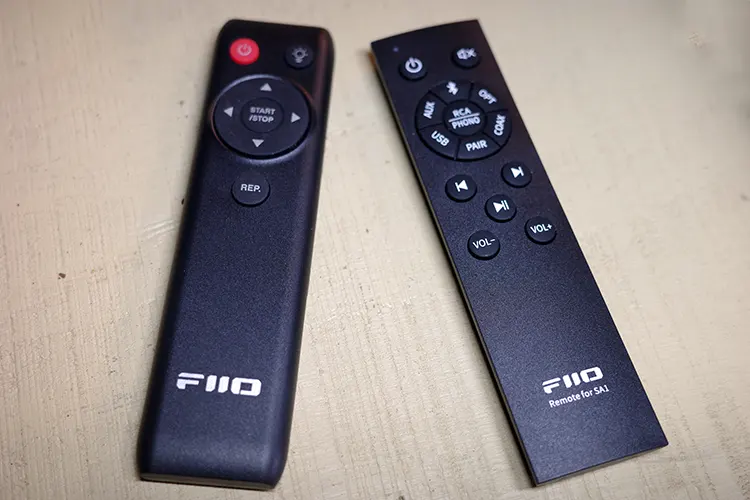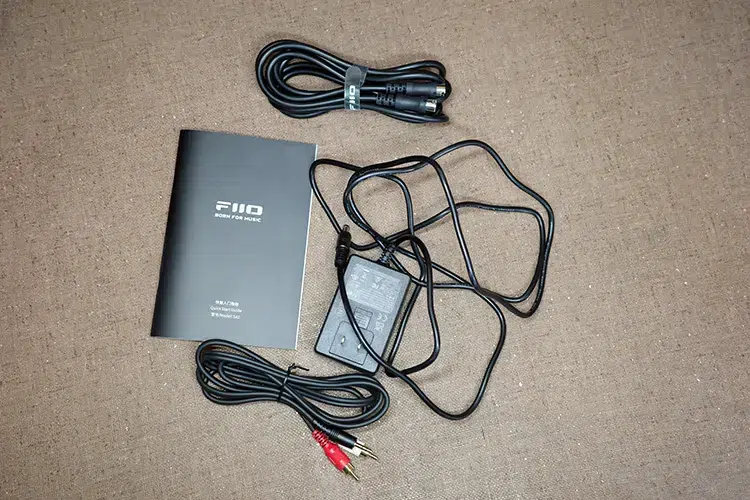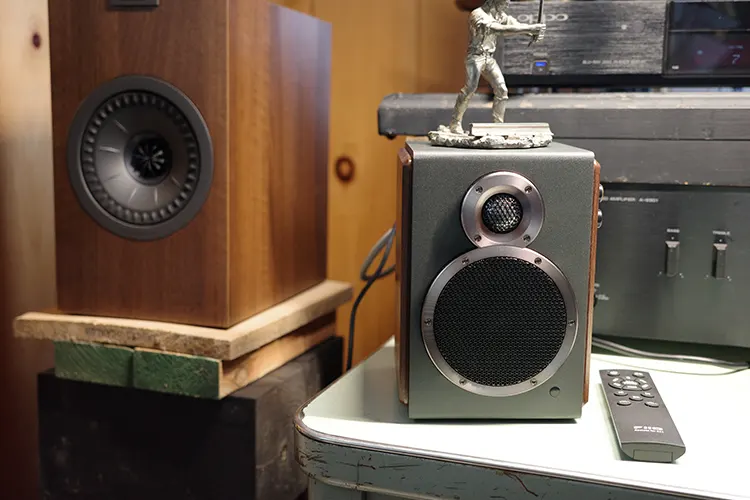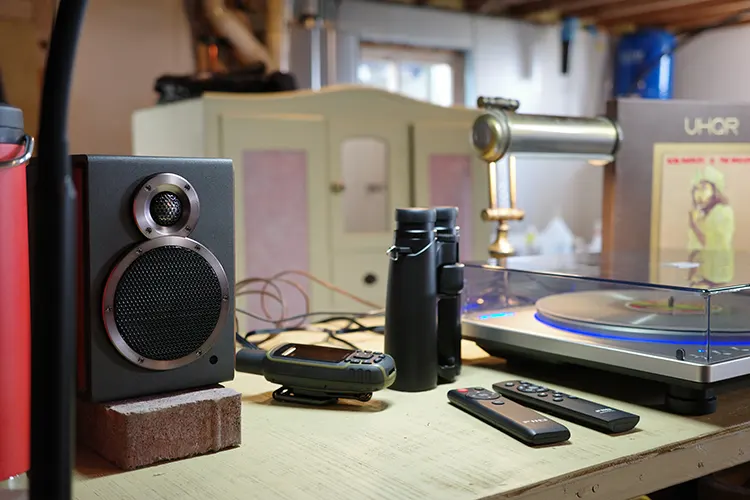Today, Lynn reviews the FiiO SA1, a new Class D desktop active speaker set with aluminum-magnesium alloy tweeters and BT LDAC support. They are currently priced at $179.99 by Amazon USA and around $200 for other markets.
Disclaimer: I received this sample in exchange for my honest opinion. Headfonics is an independent website with no affiliate links or services. I thank FiiO for their support.
You can click here to learn more about the FiiO audio products we have previously reviewed on Headfonics.
This post follows our current scoring guidelines, which you can read in more detail here.
FiiO has not stopped producing “retro” products, including the TT13 BT turntable and the recently reviewed RR11 FM radio and dongle/amplifier.
The $179.99 SA1 active speaker system seems like a perfect fit within this lineup, especially with the TT13, but it also has multiple connectivity options that can fit into many different setup options.
The SA1’s compact form factor is perfect for a desktop setup and placement. That small size works for portability aspects, too.
The ability to place a small full-range speaker in multiple locations gives it a diversity of options that can go a long way to allowing the enjoyment of our music.
That is a huge beneficial factor for the SA1, and as such, I utilized the speaker in various locations and with various sources with great success.
Features
The desktop FiiO SA1 features a 3.5” wood fiber woofer (using the same material as the FiiO FT1 headphone), which allows for a rigid structure capable of rapid acoustic response.
An aluminum-magnesium alloy tweeter using monitor-grade material measuring 0.75” allows for quick, crisp sound response, complementing the woofer.
The Texas Instruments TPA3118 Class-D amplifiers can provide up to 20W x 2 for the woofers and 5W x 2 for the tweeters. Not earth-shattering, but sufficient for desktop needs and potentially bookshelf usage in smaller spaces.
An electronic two-way crossover, at 3.5 kHz, helps maintain a balance across the sound spectrum, while the FiiO app can provide a 31-band lossless PEQ when using a Smart device as a source, which is quite flexible. The app can be used in conjunction with the PEQ to tailor the sound, fitting your space.
With a multitude of inputs, including BT 5.4, the SA1 supports LDAC when applicable, as well as AAC & SBC.
A built-in phono pre-amplifier stage can be used to connect your turntable directly, or you can connect to a BT-capable turntable that has a built-in phono stage. There is also a subwoofer output included for times when a little more low-end is desired, as in a 2.1 system.
Design
The SA1 uses high-density MDF material up to 12mm thick for the cabinet. The top and sides use 9mm solid wood veneer to reduce resonance, purportedly for a more natural sound.
Its diminutive size of just under 8” tall and 5” wide, the 5.5” fits easily upon my desk and other locations.
A lower “slot” out the back, combined with two internal shelves of unequal length, acts as a bass port. This allows the SA1 to go as low as 65Hz. A bass knob allows for added bass, but I found there was not much change to the low-end.
The 3.5” wood fiber woofer uses unequal length fibers bound together, making for a stronger, more responsive structure. The aluminum-magnesium tweeter provides for crisp, tight sound up top.
The cabinet is a good-looking unit with a dark gray faux-burnished aluminum look on the top, bottom, front, and back, that combines nicely with the walnut color of the veneer.
The dark metal smoked-chrome rings surrounding the woofer and tweeter look like a two-globe snowman, adding to the appeal.
The business parts are on the side or back of the right speaker. The three knobs on the right side of the speaker control on/off, bass enhancement, and input; which glows in the color of operation. Due to my situational locale, the speakers were switched in my office setup.
The back of the left SA1 carries the typical input/output connections ranging from an RCA/Phono input (with ground wire connection), coax, optical in, USB-C in, subwoofer out, and a 3.5mm AUX in.
Add a switch for use as either an RCA-in connection or the phono stage, and the SA1 is complete. BT connectivity is internal, with no antenna on the back.
I/O
The FiiO SA1 provides all you could ask for in a powered desktop speaker. You get RCA-in, which can be used for a source or your turntable with a switch.
You also get a USB-C for use with your Smartphone if BT is not desired, coax for use with something like a CD player, optical-in for use with sources capable of that, and BT5.4 for wireless connectivity.
A dual RCA to 3.5mm cable is also included for use out of an amplifier or use from a headphone jack on a source such as your DAP. The sub-out can connect to a comparable sub should you desire more low-end grunt.
Controls
The remote allows for complete control of the SA1 from input to volume and play/pause. The only item it cannot control is the additional bass wrought from the knob on the side of the left speaker. You can also toggle through the inputs on the left speaker using the source knob.
Turning the SA1 on and off is through the bottom button, and it can be kept in standby mode when using the remote.
I found the remote to be intuitive and easy to use, but it must be pretty much in front of the right speaker to access the IR sensor located on the bottom right of the right-hand speaker.
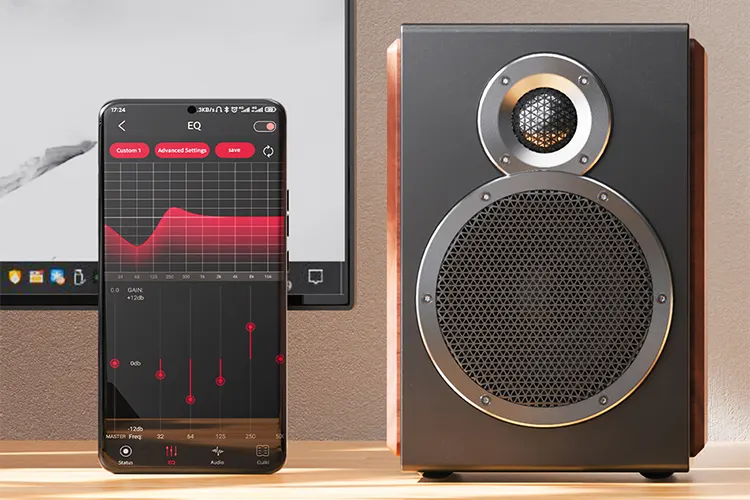
App
The FiiO Control App allows for connectivity across all FiiO devices that have Bluetooth. The addition of the SA1 brings with it a 31-band customizable PEQ, which can allow the user to fine-tune and tailor the SA1’s response for room, placement, and music being played.
Something most apps carry are “regular” EQ settings based upon anything from genre to type of response desired, such as Classical, Rock, or others. The SA1 has these features under “Custom1,” which, when toggled on, takes you to those features.
Not the most intuitive, but the options range from Jazz, to Rock, Pop, Dance, R&B, Classical, Hip-Hop, Monitor, and 3 customizable options.
Allowing the user to specify the addition or subtraction in such a customizable manner is greatly appreciated, especially for users who may have more than one preferred listening area, such as I do.
There are also three “Selected” EQ tunings if desired, and they look like they come from users who have uploaded their profiles. To be honest, all three look rather odd.
Taking the time to change the PEQ, especially when a subwoofer is added, makes for a highly customizable feature.
When on my iPhone 16 Pro Max, I added more bass to the 16- 50Hz region when set up in my unfinished basement listening area (quite large and acoustically imperfect). When in my office, I kept the PEQ flat with good results.
I did find it odd that when choosing any of the free EQ options, no back button that would allow you to return to the previous menu was found. One had to exit the app, then reload the app and reconnect to get back to the main menu.
Packaging & Accessories
The FiiO SA1 comes in a small doctor’s bag-sized box, complete with a handle. These little speakers are not all that light, so the handle is appreciated.
Under the flap, you find a soft foam tray that contains not only the power cord but remote (without batteries), a dual RCA to 3.5mm SE cable, a manual, a 4-pin XLR cable for connecting the two speakers, a power adapter, and a warranty card.
The SA1 is well-protected under the foam tray, sitting in another tray on the bottom and wrapped in thicker plastic, sealed for protection.
Sound Impressions
Listening for the SA1s was done using my iPhone 16 Pro Max, a MacBook Pro, FiiO’s JM21, the HiBy R4, and the Oppo BDP-83 as a CD transport through both coax and optical.
The Audio Technica AT-LP120XBT-USB and FiiO’s TT13 were connected via Bluetooth and RCA. The SA1 speakers were allowed to run for 75 hours before critical listening occurred.
Summary
Proper placement of these ‘Lilliputian’ speakers changes the sound drastically. This is known across two-channel systems. Differences will be noted below, but suffice it to say that even when placed on a desktop, below ear level, the sound qualities were quite adequate.
I was impressed by the holographic nature of the soundstage. Set initially as a nearfield speaker on my desktop, the SA1s promoted a spherical response to each source, with excellent depth to the sound.
As a result, imaging was excellent and placement came across as expansive without becoming thin.
Bass is lacking, but when hooked to my older Paradigm PW-2200, a faithful 20-year companion, using the included RCA to 3.5mm AUX cable, the bass expanded greatly. Details come through with aplomb and a distinctiveness defying the small speaker’s diminutive size.
The top end does suffer a bit as well, falling into an almost polite manner, but with good articulation of notes lending to a nice extension.
The midrange comes across as defined and vibrant, but without punctuating any one set of instruments or vocals present here. A work of cohesion instead of showmanship, if you will.
Placing the SA1s at ear level gives a bit more transparency along with a clearer midrange. Even when placed at desktop level, the midrange performed quite nicely.
Treble extended a bit better as one might expect with proper ear placement. The soundstage becomes a bit taller as well.
Bass
There is no getting around the diminutive size of the SA1. It is about as small as one can get for a quality offering in the desktop scene.
As such, the bass response is its most limiting factor. But the inclusion of a sub out makes up for that. One needs to be careful to match the sub with the speaker, lest you run into discrepancies in timing responses. Thankfully, the Paradigm functioned smoothly.
But, as a stand-alone, the SA1 provided a taut bass line, even if not that deep. Running the Bass Tune knob at full tilt, on my desk there was a slight amount of thump felt.
Tightly controlled, but lacking in depth, one should not discount the SA1 for use without a subwoofer. As a nearfield, the FiiO served its purpose without bother.
Mids
The midrange simply sings when called upon with punctuating, but coherent vocals. There is no thinning of notes as one might expect with such a desktop model. Instead, you get an entwined tie between the low-end and upper reaches.
The crossover set at 3.5 kHz plays a large part in this, and the FiiO engineers got this right.
While the midrange comes across as detail-oriented, there are limitations due to that size. I liken this to the younger sibling who insists on playing with the big kids, and while they do struggle a bit, you can see (and hear in this case) the qualities offered.
Instrumental music seems destined for use with the FiiO, making this a good choice when a quieter setting is needed.
The naturalness that comes through the midrange helps to slightly warm the neutral qualities offered from the tweeter and rapidly responding woofer. However, there is a slight lack of detail retrieval as expected in such a diminutively sized speaker.
Treble
That carries over into the upper reaches. While not punctuating like the midrange, there is good extension that comes across as clear and crisp, but can play nicely at lower levels.
The 0.75” aluminum-magnesium alloy allows for that crispness to provide excellent detail retrieval and separation of not only instruments, but vocals that carry into the top regions as well.
There is good sparkle to the upper reaches, without becoming too sparkly or brittle. You can tell this is a small driver and one made of an alloy, but that does not diminish the quality offered.
The to-end also carries a bit more clarity of note than the midrange.
Staging & Dynamics
I mentioned how the soundstage threw me for a loop. More expansive than I would have thought, the SA1 has excellent 3D weight. Even when placed right on my desktop, the expansion of sound rises to above head level, with a depth beyond my office window and somewhat behind me.
The width matches the speaker placement well, giving either a somewhat intimate width or expansive sound when spaced further apart (approx. 6’).
I was very impressed with the three-dimensional aspect of the SA1’s, which have a bigger aspect to it than they have a right to. Think “walk tall and carry a big stick,” aspect, and this describes the breadth, width, and height of the soundstage.
The imaging is at the mercy of the speaker size in the case of the SA1, but that 3D feel allows for good placement of instruments. There is a central meeting of instruments that detracts a bit from the overall sensation, but the width and height help counter that with good left/right and up/down intervention.
Using the AT turntable through BT allowed for the expansion of music being played in all dimensions. However, when hooked to the Oppo, the ability of proper placement dutifully shone as a must.
Click on page 2 below for my recommended pairings and selected comparisons.

